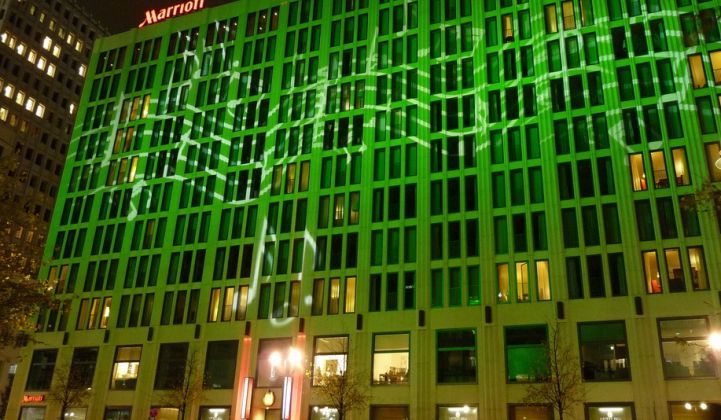Here’s a new demand response deal that shows just how complicated the business of turning down power use to balance the grid and save money is becoming. Constellation Energy and Marriott International just announced a project aimed at delivering 23 megawatts of controllable load across 264 hotel properties in the Northeast, Mid-Atlantic, Texas and California.
That’s not a huge deal for the demand response industry in megawatt terms. Big DR provider EnerNOC has nearly 7,000 megawatts under management, and Constellation has about 4,400 megawatts. Still, the project is an interesting demonstration of just how many different ways there are to tap that power, and to what different ends.
Marriott isn’t a newcomer to demand response -- Douglas Rath, the company’s energy director for North America, said it has been doing old-fashioned, manual-style DR for more than a decade. But the company wants to cut total energy use at its hotels by 25 percent from 2007 to 2017, and has decided that automating energy controls across its myriad properties -- which are owned by groups other than Marriott, by the way -- is the way to get there.
But how to justify the investment in energy-smart building automation? Rath said that Marriott decided it needed some kind of platform that could offer hotel properties in different states and utility jurisdictions a more standardized way to tap the utility incentives that come along with hooking up building automation systems to demand response programs.
“So we certainly went after that -- and Constellation brought to us a piece that nobody else seemed to have,” Rath said. That piece is Constellation’s VirtuWatt platform, a web-based interface that gives insight and control over power management from the individual hotel level to the company-wide level.
Think of it as “a tool to facilitate, as easily and as cheaply as possible, the participation in the energy markets,” said Gary Fromer, SVP of demand response at Constellation and former CEO of CPower, the East Coast demand response company that Constellation bought last year.
Since it launched last year, almost all of Constellation-CPower’s demand response customers have switched over to using VirtuWatt to play into traditional demand response programs, where power users agree to shed load on utility command, Fromer said.
But many are also using the platform to “respond to other energy market stimuli,” as Fromer terms it, whether these stimuli may be plotting out power use plans based on day-ahead pricing conditions, avoiding peak overuse charges or even playing “negawatts” of power reduction into synchronized reserves markets.
Of course, individual hotel facility managers don’t have the time or training to play their HVAC and lighting systems on energy markets, so “We’re doing that behind the scenes with Marriott senior management,” Fromer explained. “VirtuWatt gives a window into what the power available is at any given time, and the customer can set up curtailment scenarios,” or preset responses to different power prices and utility commands.
Not all of Marriott’s 264 participating properties have the same level of building automation installed. About 120 of them were already using a platform from Kennesaw, Ga.-based Automated Logic, and part of Constellation’s job was to interface VirtuWatt with those systems, Rath noted.
Another 53 of the hotels are using VirtuWatt on its own as the primary building control system, while another 90 or so are still participating manually, since they’re in markets that don’t offer big utility incentives for automating demand response, he said. In every case, the load shedding has to be done in a way that doesn’t inconvenience hotel guests or drive facility managers crazy, Rath noted. (Here’s a YouTube video on the project, if you’re interested.)
The companies haven’t disclosed the cost of the project or how long they expect them to take to pay off, either in terms of energy efficiency improvements and revenues from demand response and energy market participation. Rath did note that Marriott hopes to collect a combined $1.3 million in incentives around the country for the installation of the systems, highlighting once again how important utility backing is for these kinds of projects.
That’s not a fact lost on competitors like EnerNOC, which has a whole host of energy services platforms it offers to its customers. Likewise, energy services companies like Schneider Electric are combining power procurement and building controls in a way meant to help customers play their power use into utility programs and energy markets.
Indeed, it could be argued that demand response companies have already collected many of the big, centralized power users that can turn large blocks of power on and off for economic advantage. The next wave of demand response will have to come in a more incremental, modular approach like the one Marriott and Constellation are trying out.
Indeed, over time, smart grid-smart building integration may increasingly blur the line between demand response and simply being a smart energy consumer. We’ve got a long way to go before we get there, but it’s worth keeping an eye on these developments.



